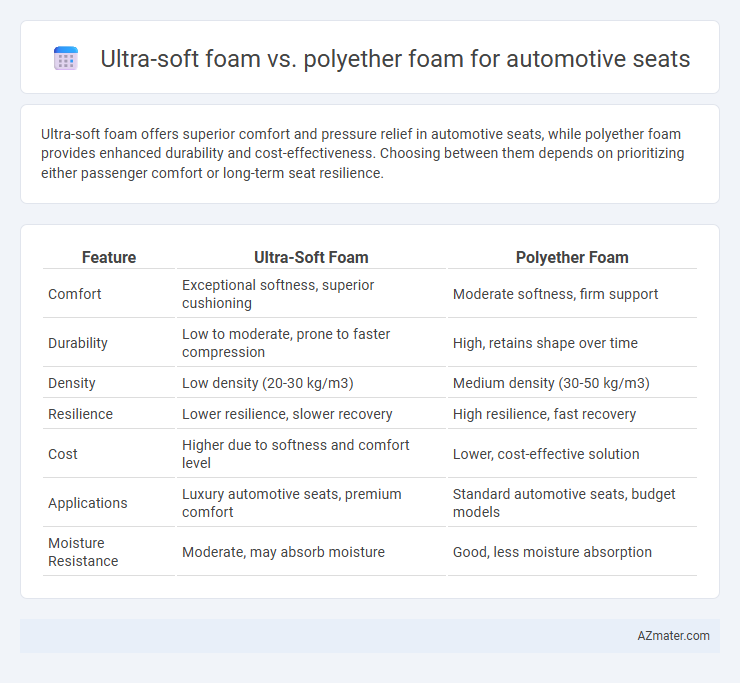Ultra-soft foam offers superior comfort and pressure relief in automotive seats, while polyether foam provides enhanced durability and cost-effectiveness. Choosing between them depends on prioritizing either passenger comfort or long-term seat resilience.
Table of Comparison
| Feature | Ultra-Soft Foam | Polyether Foam |
|---|---|---|
| Comfort | Exceptional softness, superior cushioning | Moderate softness, firm support |
| Durability | Low to moderate, prone to faster compression | High, retains shape over time |
| Density | Low density (20-30 kg/m3) | Medium density (30-50 kg/m3) |
| Resilience | Lower resilience, slower recovery | High resilience, fast recovery |
| Cost | Higher due to softness and comfort level | Lower, cost-effective solution |
| Applications | Luxury automotive seats, premium comfort | Standard automotive seats, budget models |
| Moisture Resistance | Moderate, may absorb moisture | Good, less moisture absorption |
Introduction to Automotive Seat Foams
Ultra-soft foam and polyether foam represent two common materials used in automotive seat cushioning, each offering distinct comfort and durability characteristics. Ultra-soft foam provides superior cushioning and pressure distribution, enhancing passenger comfort during long drives, while polyether foam is known for its resilience and cost-effectiveness, maintaining structural support over time. Understanding the balance between softness and durability is critical in selecting the optimal foam for automotive seats, ensuring both comfort and longevity in vehicle interiors.
What is Ultra-Soft Foam?
Ultra-soft foam used in automotive seats is a highly flexible, low-density material designed to provide exceptional comfort and pressure distribution by conforming closely to the occupant's body shape. Unlike polyether foam, which is durable and resilient but firmer, ultra-soft foam offers superior softness and cushioning, enhancing long-duration driving comfort and reducing fatigue. This foam's open-cell structure allows better airflow, contributing to improved breathability and thermal regulation within vehicle seating.
Understanding Polyether Foam
Polyether foam in automotive seats offers excellent resilience and durability, maintaining its shape and comfort over extended periods of use. It provides superior breathability and moisture resistance compared to ultra-soft foam, enhancing occupant comfort during long drives. Its cost-effectiveness and high load-bearing capacity make polyether foam a preferred choice for manufacturing durable, comfortable automotive seating solutions.
Comfort Comparison: Ultra-Soft vs Polyether Foam
Ultra-soft foam offers superior cushioning and pressure distribution in automotive seats, enhancing occupant comfort during long drives compared to polyether foam. Polyether foam, while more resilient and durable, tends to be firmer and less adaptive to body contours, potentially causing discomfort over extended use. The balance between softness and support makes ultra-soft foam the preferred choice for luxury and comfort-focused automotive seating.
Durability and Longevity
Ultra-soft foam provides enhanced comfort in automotive seats but tends to have lower durability compared to polyether foam, which is renowned for its robustness and resistance to wear and tear. Polyether foam maintains its structural integrity and cushioning properties over extended periods, making it ideal for long-term use in vehicle seating. The choice between ultra-soft and polyether foam impacts the seat's lifespan significantly, with polyether foam offering superior longevity under frequent use and varying temperature conditions.
Support and Ergonomics
Ultra-soft foam in automotive seats provides enhanced cushioning and comfort by conforming closely to the body's contours, promoting better weight distribution and pressure relief for improved ergonomics. Polyether foam offers firmer support with higher resilience and durability, maintaining shape under prolonged use, which supports spinal alignment and overall posture stability. Selecting between these foams depends on balancing immediate comfort needs with long-term structural support to optimize driver and passenger ergonomics.
Breathability and Temperature Regulation
Ultra-soft foam offers superior breathability compared to polyether foam, promoting better airflow through its open-cell structure, which effectively reduces heat buildup during long drives. Polyether foam, with its closed-cell design, tends to retain heat and moisture, leading to less efficient temperature regulation and potential discomfort. Automotive seats incorporating ultra-soft foam enhance occupant comfort by maintaining a cooler surface temperature and improving moisture evaporation, making them ideal for extended use in varying climates.
Cost Analysis: Ultra-Soft vs Polyether Foam
Ultra-soft foam generally incurs higher costs than polyether foam due to its advanced material properties and enhanced comfort levels desirable in premium automotive seats. Polyether foam remains a cost-effective choice with lower raw material expenses and simpler manufacturing processes, making it suitable for economy and mid-range vehicles. Evaluating total lifecycle costs, ultra-soft foam may increase initial investment but offers potential value through improved durability and passenger comfort.
Environmental Impact and Sustainability
Ultra-soft foam used in automotive seats often contains higher levels of petrochemicals and has lower biodegradability compared to polyether foam, leading to increased environmental impact. Polyether foam, with its simpler chemical structure, tends to be more recyclable and has a smaller carbon footprint during production. Sustainable automotive seating solutions increasingly favor polyether foam due to its improved recyclability and reduced reliance on non-renewable resources.
Choosing the Right Foam for Automotive Seats
Ultra-soft foam offers exceptional comfort and cushioning, making it ideal for luxury automotive seats that prioritize passenger comfort on long drives. Polyether foam provides a cost-effective solution with good load-bearing capacity and durability, suitable for standard automotive seating applications requiring firm support and resilience. Selecting the right foam involves balancing comfort, durability, and cost, with ultra-soft foam favored for premium vehicles and polyether foam commonly used in mass-produced models.

Infographic: Ultra-soft foam vs Polyether foam for Automotive seat
 azmater.com
azmater.com